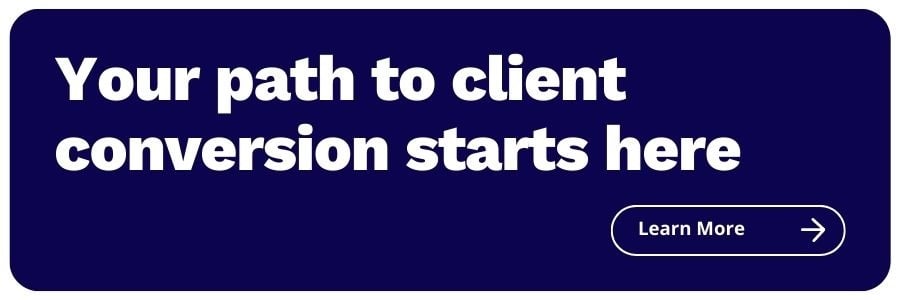14 Sales Hacks for Independent Financial Advisors
Share this
Sales. This word has a strange way of making people cringe. Maybe because when most of us think of sales, we immediately imagine a used car salesman—that stereotypical over-enthusiastic, slick-tongued guy who makes a living by overpromising and underdelivering.
But is that really what sales is all about? Nope. With the right tools, the act (some would call it an art) of selling transforms from sleazy to strategic. So saddle up and learn to love the "s" word because as a firm owner, sales plays a critical role in the success of your business.
For this blog, I turned to my colleagues across XY Planning Network, XY Investment Solutions, XY Bean Counters, and AdvicePay to pull together our top sales “hacks” to share with you. I hope these tips and tricks give you a fresh perspective on the art of selling and inspire you to try some new ideas.
#1. Take the Time to Prepare
 Take 15 minutes to look around the web to see if there is anything you can learn about your prospective clients. Any detail you can address, such as where they live, the name of their firm or their partner, etc, will help you establish rapport and let the prospect know you care enough to try to get to know them.
Take 15 minutes to look around the web to see if there is anything you can learn about your prospective clients. Any detail you can address, such as where they live, the name of their firm or their partner, etc, will help you establish rapport and let the prospect know you care enough to try to get to know them.
–Dan Keslin, Sales and Bookkeeper at XY Bean Counters
 Check out a prospect’s LinkedIn profile and glean what you can to forge a connection. Maybe they went to the same school as you or work/worked with friends of yours. Read the latest company info and social feeds to get a feel for what may be going on in their work life and any projects they may have been on. Doing a little digging will give you insight into who your prospect is.
Check out a prospect’s LinkedIn profile and glean what you can to forge a connection. Maybe they went to the same school as you or work/worked with friends of yours. Read the latest company info and social feeds to get a feel for what may be going on in their work life and any projects they may have been on. Doing a little digging will give you insight into who your prospect is.
–Brandon Moss, Director of XY Investment Solutions
#2. Set Expectations...and Actually Meet Them
 If a prospect isn’t ready to make a decision, that’s okay. It isn’t your job to strong-arm them into becoming your client; it’s your job to gauge their interest to determine if they simply need more time before making a decision, or if that sale is just never going to happen. You don’t waste your time, or theirs. Set an expectation with them that you will reach out to them in X number of days to make sure they have a clear understanding of the value of your product or service. Be sure to meet the expectation that you set.
If a prospect isn’t ready to make a decision, that’s okay. It isn’t your job to strong-arm them into becoming your client; it’s your job to gauge their interest to determine if they simply need more time before making a decision, or if that sale is just never going to happen. You don’t waste your time, or theirs. Set an expectation with them that you will reach out to them in X number of days to make sure they have a clear understanding of the value of your product or service. Be sure to meet the expectation that you set.
–Dan Keslin, Sales and Bookkeeper at XY Bean Counters
 You wouldn’t tell a family member or friend that you’re going to do something for them and then not do it (at least I hope you wouldn’t!). This should be the same philosophy you hold in your sales process. If you tell a prospective client you will send them a follow-up email with additional resources, then make sure you do it. This is all part of the process of building a trustworthy sales process. You are showing your potential client that you care about what they are trying to accomplish because you are not only listening, but also following through and providing helpful information.
You wouldn’t tell a family member or friend that you’re going to do something for them and then not do it (at least I hope you wouldn’t!). This should be the same philosophy you hold in your sales process. If you tell a prospective client you will send them a follow-up email with additional resources, then make sure you do it. This is all part of the process of building a trustworthy sales process. You are showing your potential client that you care about what they are trying to accomplish because you are not only listening, but also following through and providing helpful information.
–Lindsey Harrington, Lead Sales Associate at XY Planning Network
#3. Embrace the Silence
 During every conversation that you have, you'll ask a question. What is the best thing you can do afterward? Stop talking. It may feel awkward or uncomfortable, but the longer the silence, the better. This gives your prospect time to think. It also implies that they are interested in the conversation you are having and are thinking through their response. We often get nervous and try to fill the silence with another question or offer up an explanation. This breaks off your prospect’s engagement. Give them time, don’t interrupt them, and embrace the silence. This also gives your prospect the opportunity to guide the conversation in the direction they want to go. By evaluating what the prospect brings up next, you can determine what part of your service the prospective client is especially interested in or where they have concerns.
During every conversation that you have, you'll ask a question. What is the best thing you can do afterward? Stop talking. It may feel awkward or uncomfortable, but the longer the silence, the better. This gives your prospect time to think. It also implies that they are interested in the conversation you are having and are thinking through their response. We often get nervous and try to fill the silence with another question or offer up an explanation. This breaks off your prospect’s engagement. Give them time, don’t interrupt them, and embrace the silence. This also gives your prospect the opportunity to guide the conversation in the direction they want to go. By evaluating what the prospect brings up next, you can determine what part of your service the prospective client is especially interested in or where they have concerns.
–Lindsey Harrington, Lead Sales Associate at XY Planning Network
 Don’t fear the awkward silence. Pauses are ok. Usually, if you just wait and listen, the prospect will start talking and share something valuable that will clue you in on how you can best address their needs.
Don’t fear the awkward silence. Pauses are ok. Usually, if you just wait and listen, the prospect will start talking and share something valuable that will clue you in on how you can best address their needs.
–Dan Keslin, Sales and Bookkeeper at XY Bean Counters
#4. Build a Relationship
 Approach the conversation with a relationship-building mindset instead of thinking of the interaction as little more than a transaction. Take advantage of the opportunity to get to know the prospect and their unique needs and circumstances before diving into your offering and how it could help address those needs. Always leave the conversation open with an agreed upon plan for future communication.
Approach the conversation with a relationship-building mindset instead of thinking of the interaction as little more than a transaction. Take advantage of the opportunity to get to know the prospect and their unique needs and circumstances before diving into your offering and how it could help address those needs. Always leave the conversation open with an agreed upon plan for future communication.
–Stacey Unruh, Director of Sales at XY Planning Network
#5. Set an Agenda
 Can you imagine heading out on a road trip with someone else in the driver’s seat and having no idea where you’re going? I don’t know about you, but that sounds like a nightmare to me. Your prospective clients are no different. They want an idea of where your meeting is headed, so give it to them. It will make them more comfortable right at the start.
Can you imagine heading out on a road trip with someone else in the driver’s seat and having no idea where you’re going? I don’t know about you, but that sounds like a nightmare to me. Your prospective clients are no different. They want an idea of where your meeting is headed, so give it to them. It will make them more comfortable right at the start.
This is a great opportunity to show your prospect up front that you understand this meeting isn’t about you—it’s about them. It is also a good check in to make sure you’re both on the same page. By taking just a few minutes at the start of a meeting to share your agenda, you will already be well on your way to building a relationship with your prospective client and you will learn more about their expectations (and possibly get a leg up on other advisors the client may be meeting with).
–Cassie Jackson, Business Development at AdvicePay
#6. Always Be Helpful
 In the world of internet reviews and social media, your prospect holds all the cards. They can research anyone and anything on the internet, and if you aren’t a fit, they’ll be moving on. So when working with prospects, you need to always help and be of service to them. Be a guide for your prospect and lead them in the right direction. You can use your expertise to guide your prospect through your sales process. Work with them to understand how they make decisions and how you can best help them with their unique situation. Don’t treat every prospect the same exact way. Establish a trustworthy relationship by listening to them, respecting them, and helping them.
In the world of internet reviews and social media, your prospect holds all the cards. They can research anyone and anything on the internet, and if you aren’t a fit, they’ll be moving on. So when working with prospects, you need to always help and be of service to them. Be a guide for your prospect and lead them in the right direction. You can use your expertise to guide your prospect through your sales process. Work with them to understand how they make decisions and how you can best help them with their unique situation. Don’t treat every prospect the same exact way. Establish a trustworthy relationship by listening to them, respecting them, and helping them.
–Lindsey Harrington, Lead Sales Associate at XY Planning Network
#7. You Don’t Always Have to Say "Yes"
 Know when to say "no." Your service shouldn't be for everyone (did you really think we could get through a blog without at least hinting at the value of having a niche?). Moving forward with customer relationships that do not meet your ideal customer profile will end up costing both you and the customer in the long run. It's best in these instances to discuss how your solution might not be what they're looking for and provide alternatives for them.
Know when to say "no." Your service shouldn't be for everyone (did you really think we could get through a blog without at least hinting at the value of having a niche?). Moving forward with customer relationships that do not meet your ideal customer profile will end up costing both you and the customer in the long run. It's best in these instances to discuss how your solution might not be what they're looking for and provide alternatives for them.
–Stacey Unruh, Director of Sales at XY Planning Network
#8. Be Okay with Rejection
 Not everyone will see the value in your product or service. Do your best to not take this personally and believe in yourself. Just know that you will have rejections and that is all part of the sales process!
Not everyone will see the value in your product or service. Do your best to not take this personally and believe in yourself. Just know that you will have rejections and that is all part of the sales process!
–Dan Keslin, Sales and Bookkeeper at XY Bean Counters
#9. Be Authentic
 Talk to people as people. Treat your prospects well and never try to coerce them into something they may not want or need. Being authentic means that you believe in your product and you believe that what you are selling can help people. Don't be sleazy, don't be slimy, don't be like every other salesperson out there. Be you. Be authentic.
Talk to people as people. Treat your prospects well and never try to coerce them into something they may not want or need. Being authentic means that you believe in your product and you believe that what you are selling can help people. Don't be sleazy, don't be slimy, don't be like every other salesperson out there. Be you. Be authentic.
–Janson Evans, Director of Enterprise Sales at AdvicePay
#10. Take Time to Learn about Different Personality Types
 I love this quote from Isabel Briggs Myers:
I love this quote from Isabel Briggs Myers:
"If you don't know what an extravert thinks, you haven't been listening. If you don't know what an introvert thinks, you haven't asked them!"
People are wired to make purchasing decisions differently because at their very core, they are wired to hear and speak differently. We have all experienced a meeting where someone just wants to get down to business. They aren’t interested in small talk or filler conversation. They came to the meeting for a purpose and they want to get to it as quickly as possible. On the other hand, there are people that prefer to ease into things. They might consider jumping right into business rude.
Your personality type doesn’t matter in sales—but your prospect’s personality type does. When meeting with a prospective client, many professionals have a rehearsed sales pitch that is based on their own personality. If the person you’re meeting with is very different from you, you may not connect well with them using your rehearsed pitch. Regardless of the value you’re able to bring them, they may not want to work with you. When you adjust your style to theirs, they will be much more receptive to working with you. Be willing to toss the script and genuinely connect with prospects on their terms.
–Cassie Jackson, Business Development at AdvicePay
#11. SMILE and Get on Camera
 Talk is cheap. But when you can see someone and look them in the eye...CONNECTION! Practice and get good on camera. And SMILE! It's so simple but just making a concerted effort to smile and stay engaged will resonate with your prospect—they will pick up on, and in many cases mirror, your energy. Lastly, always act like you're interested (even if you're not).
Talk is cheap. But when you can see someone and look them in the eye...CONNECTION! Practice and get good on camera. And SMILE! It's so simple but just making a concerted effort to smile and stay engaged will resonate with your prospect—they will pick up on, and in many cases mirror, your energy. Lastly, always act like you're interested (even if you're not).
–Brandon Moss, Director of XY Investment Solutions
#12. Practice Makes Perfect
 The more comfortable you feel responding to questions, knowing your service, and working through difficult situations, the better you will feel on your call or in your meeting. If sales is new to you, just keep doing it and you will drastically improve every time.
The more comfortable you feel responding to questions, knowing your service, and working through difficult situations, the better you will feel on your call or in your meeting. If sales is new to you, just keep doing it and you will drastically improve every time.
–Dan Keslin, Sales and Bookkeeper at XY Bean Counters
#13. Track It
 Basic, right? But you need good notes—and a place to store those notes—to make things happen and maintain that connection. You also need to keep good tabs on any promises made and honor any timelines you may have suggested. This shows prospective clients you are trustworthy and a person of your word.
Basic, right? But you need good notes—and a place to store those notes—to make things happen and maintain that connection. You also need to keep good tabs on any promises made and honor any timelines you may have suggested. This shows prospective clients you are trustworthy and a person of your word.
Tracking is also good practice for pipeline monitoring and scoring. Tracking helps you predict basic business growth and other analytics to help build and sustain your business, and also helps you identify when to make investments in your business. If you know you have 23 prospects or clients who all have stock options ready to exercise next year, you can plan and strategize accordingly. Plus, your business is worth more if you can prove this data to a potential buyer. Organic growth sells.
–Brandon Moss, Director of XY Investment Solutions
#14. Save Yourself Time
 Ever gone back and forth via email with someone trying to find a time to connect that works for both of your schedules? It’s not fun. It’s also a huge waste of time. Automate this process and purchase scheduling software. There are many super affordable options, like Calendly, that allow you to easily schedule meetings by simply sharing a link to your calendar. (Hint: Calendly even has a free version that is more than adequate for many advisors!)
Ever gone back and forth via email with someone trying to find a time to connect that works for both of your schedules? It’s not fun. It’s also a huge waste of time. Automate this process and purchase scheduling software. There are many super affordable options, like Calendly, that allow you to easily schedule meetings by simply sharing a link to your calendar. (Hint: Calendly even has a free version that is more than adequate for many advisors!)
–Lindsey Harrington, Lead Sales Associate at XY Planning Network
 About the Author
About the Author
Lindsey Harrington is known as the Growth Guru at XYPN, helping prospective members learn more about membership and what it takes to join our growing community. She is passionate about sharing the tools and resources the community has to offer to help individuals start, run, and grow their own fee-only financial planning practices.
Share this
- Fee-only advisor (381)
- Advice (305)
- Business Development (248)
- Independent Financial Advisor (203)
- Growing Your Firm (161)
- Marketing (133)
- Financial Planning (129)
- What Would Arlene Say (WWAS) (81)
- Business Coach (80)
- Firm Ownership (78)
- Training (75)
- Compliance (72)
- Business (69)
- Building Your Firm (65)
- Financial Advisors (63)
- Online Marketing (61)
- Events (59)
- Starting a Firm (52)
- Staffing & HR (49)
- Technology (49)
- From XYPN Members (48)
- Launching a firm (46)
- Advisors (41)
- Entrepreneurship (38)
- Taxes (37)
- Networking & Community (33)
- Interviews and Case Studies (32)
- Investment Management (31)
- Sales (27)
- Social Responsibility (27)
- Tax Preparation (27)
- XYPN Invest (26)
- Business Owner (25)
- Small Business Owner (20)
- Financial Management & Investment (19)
- Industry Trends & Insights (19)
- Financial Education (17)
- Financial Planners (17)
- Independent Financial Planner (17)
- Tech Stack (17)
- XYPN (17)
- Leadership & Vision (16)
- Investing (15)
- Niche (15)
- How to be a Financial Advisor (14)
- NextGen (14)
- RIA (14)
- Media (13)
- Preparing to Launch (13)
- Press Mentions (13)
- RIA Operations (12)
- RIA Owner (12)
- XYPN Membership (12)
- Assets Under Management (AUM) (11)
- First Year (11)
- Goals (11)
- Scaling (10)
- Advisor Success (9)
- Building Your Firm (8)
- Communication (8)
- Lessons (8)
- Study Group (8)
- Time Management (8)
- Virtual Advisor (8)
- Behavioral Finance (7)
- Growth (7)
- Pricing Models (7)
- From Our Advisors (6)
- Independent RIA (6)
- Money Management (6)
- Motivation (6)
- Processes (6)
- Automation (5)
- Broker-Dealers (5)
- College Planning (5)
- Filing Status (5)
- How I Did It series (5)
- Investment Planner (5)
- Mental Health (5)
- Michael Kitces (5)
- Preparing to Launch (5)
- RIA Operations (5)
- Retirement (5)
- Risk and Investing (5)
- S Corpration (5)
- Support System (5)
- TAMP (5)
- Wealth (5)
- Year-End (5)
- Client Services (4)
- Outsourcing (4)
- Selling a Firm (4)
- Succession Plans (4)
- Benchmarking Study (3)
- Budgeting (3)
- Career Changers (3)
- Engagement (3)
- Fiduciary (3)
- Getting Leads (3)
- Membership (3)
- Millennials (3)
- Monthly Retainer Model (3)
- Partnership (3)
- Pricing (3)
- Recordkeeping (3)
- Risk Assessment (3)
- Small Business (3)
- Staying Relevant (3)
- Work Life Balance (3)
- Advice-Only Planning (2)
- Bookkeeping (2)
- Charitable Donations (2)
- Client Acquisition (2)
- Differentiation (2)
- Health Care (2)
- IRA (2)
- Inflation (2)
- Productivity (2)
- Implementing (1)
Subscribe by email
You May Also Like
These Related Stories

Want More Clients? Follow This Sales Philosophy

9 Sales Habits of Highly Successful Firm Owners





